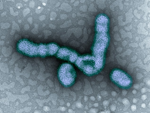immunology wars
may your immune system defend you
Vaccination

Source: NIAID (CC)
Vaccination has saved more lives than any other medical intervention; it was first discovered in 1796 by Edward Jenner, who realised that individuals who had suffered from cow pox were less susceptible to the potentially fatal small pox virus.
The basic premise of vaccination is stimulation of the adaptive immune response and immune memory, whereby once the immune system has encountered a threat it remembers it and is able to respond more robustly if encountered again. Fortunately the pathogen does not need to be intact in order to stimulate the immune system and provide this memory. There are many different types of vaccines, ones where the pathogen has been killed or inactivated, those where the pathogen is alive, but is unable to cause disease and those where toxins released by the pathogen are targeted to indirectly neutralise the threat.

Source: NIAID (CC)
Vaccination has been incredibly successful, virtually wiping out infectious diseases such as smallpox, polio and tetanus from much of the world. In part this has been due to herd immunity, where a sufficiently large proportion of the population has been vaccinated, effectively preventing the spread of the disease. However, there are still some diseases that do not have a vaccine, including HIV and malaria, for which new strategies will need to be developed.
Vaccination has been a hot topic in the media, like any medicine or medical procedure, vaccines are not 100% risk free. Minor side effects like soreness and low grade fever are common and major side effects are very rare and occurring in about 1 in every 100,000 vaccinations, typically resulting in an allergic reaction. Extensive testing is required before any vaccine reaches the market to ensure its safety.
Cells
- Basophils
- Eosinophils
- Mast Cells
- Neutrophils
- Monocytes / Macrophages
- Natural Killer Cells
- Dendritic Cells
- B-Lymphocytes
- T-Lymphocytes
- CD4+ T-Lymphocytes
- CD8+ T-Lymphocytes
- Regulatory T-lymphocytes
- Th17 Lymphocytes
